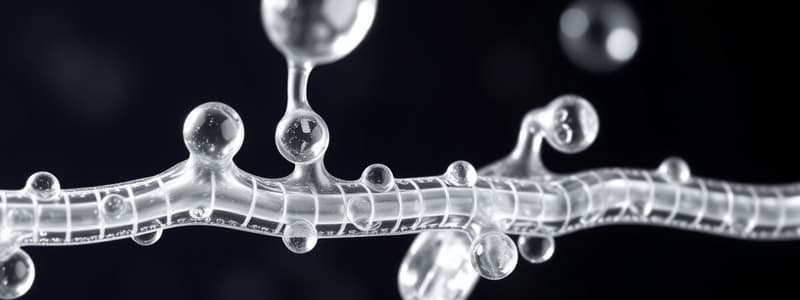Podcast
Questions and Answers
What does clearance primarily represent in pharmacokinetics?
What does clearance primarily represent in pharmacokinetics?
- The rate at which a compound is eliminated from systemic circulation (correct)
- The rate at which a drug is absorbed into the bloodstream
- The total volume of blood perfusing an organ
- The concentration of a drug in the plasma
Which organs are primarily involved in drug clearance?
Which organs are primarily involved in drug clearance?
- Heart and lungs
- Liver and kidneys (correct)
- Lungs and intestines
- Liver and stomach
Which statement regarding bioavailability is accurate?
Which statement regarding bioavailability is accurate?
- Bioavailability is the quantity of drug eliminated in urine
- Bioavailability measures the percentage of a drug that reaches systemic circulation unchanged (correct)
- Bioavailability only considers drugs administered intravenously
- Bioavailability is determined solely by hepatic metabolism
What factor does NOT affect the bioavailability of orally administered drugs?
What factor does NOT affect the bioavailability of orally administered drugs?
In first order kinetics, which of these statements is true?
In first order kinetics, which of these statements is true?
What happens during zero order kinetics with a substance like alcohol?
What happens during zero order kinetics with a substance like alcohol?
Which measurement reflects the extent of drug absorption in pharmacokinetics?
Which measurement reflects the extent of drug absorption in pharmacokinetics?
Which of the following is NOT a route of drug elimination?
Which of the following is NOT a route of drug elimination?
What does the calculation for bioavailability involve when comparing oral and intravenous (IV) routes?
What does the calculation for bioavailability involve when comparing oral and intravenous (IV) routes?
What is the impact of high fiber foods on drug absorption?
What is the impact of high fiber foods on drug absorption?
How does grapefruit juice affect drug metabolism?
How does grapefruit juice affect drug metabolism?
Which of the following is a key focus of pharmacogenetics?
Which of the following is a key focus of pharmacogenetics?
What distinguishes pharmacogenetic defects from other inborn errors of metabolism?
What distinguishes pharmacogenetic defects from other inborn errors of metabolism?
Which statement correctly describes the genetic subdivisions in pharmacogenetics?
Which statement correctly describes the genetic subdivisions in pharmacogenetics?
What role does heritability play in pharmacogenetics?
What role does heritability play in pharmacogenetics?
What is the primary function of high-calorie food in drug absorption?
What is the primary function of high-calorie food in drug absorption?
Which of the following is NOT a characteristic of genetic polymorphisms?
Which of the following is NOT a characteristic of genetic polymorphisms?
Why can some drug effect variabilities be attributed to genetic factors?
Why can some drug effect variabilities be attributed to genetic factors?
What is a major risk associated with polypharmacy?
What is a major risk associated with polypharmacy?
Which enzyme family primarily metabolizes a wide range of drugs including beta-adrenoceptor blockers?
Which enzyme family primarily metabolizes a wide range of drugs including beta-adrenoceptor blockers?
What condition increases the risk of hemolytic drug reactions due to its effect on red blood cells?
What condition increases the risk of hemolytic drug reactions due to its effect on red blood cells?
What percentage of drug-related fatalities involve alcohol in combination with other drugs?
What percentage of drug-related fatalities involve alcohol in combination with other drugs?
Which statement is true regarding acetaminophen toxicity?
Which statement is true regarding acetaminophen toxicity?
What is the maximum tolerated dose (MTD) aimed to evaluate in drug testing?
What is the maximum tolerated dose (MTD) aimed to evaluate in drug testing?
Chronic or heavy alcohol use can alter drug responses primarily through which mechanism?
Chronic or heavy alcohol use can alter drug responses primarily through which mechanism?
Which factor most significantly distinguishes pharmacokinetic changes from pharmacodynamic changes in drug therapy?
Which factor most significantly distinguishes pharmacokinetic changes from pharmacodynamic changes in drug therapy?
What is the effect of tobacco smoke on drug metabolism?
What is the effect of tobacco smoke on drug metabolism?
What can be a consequence of metabolizing certain drugs too rapidly due to environmental exposure?
What can be a consequence of metabolizing certain drugs too rapidly due to environmental exposure?
Study Notes
Clearance (CL)
- Clearance is a critical ADME parameter reflecting the rate at which compounds are removed from systemic circulation.
- Primary organs involved are the liver (metabolism and biliary excretion) and kidneys (urinary excretion).
- Drug clearance does not change and is a quantitative measure of drug elimination.
- Routes of drug elimination include hepatic biotransformation, kidney and bile excretion, exhalation, and fecal excretion.
- Clearance is expressed in terms of volume of body fluid cleared of a drug per unit time.
Bioavailability
- Bioavailability measures the percentage of unchanged drug entering the systemic circulation post-administration.
- AUC (area under the curve) reflects drug absorption and is calculated as:
- Bioavailability = [AUC (oral) / AUC (IV)] x 100%
- Factors affecting bioavailability include:
- Drug formulation affecting dissolution time.
- Drug interactions in the GI tract, such as complex formation.
- Biotransformation before entering systemic circulation.
Kinetics of Drug Metabolism
- First Order Kinetics:
- Drug metabolism is concentration-dependent with a constant percentage metabolized and constant half-life.
- Zero Order Kinetics:
- Metabolism is independent of concentration with a constant amount metabolized; half-life varies, leading to overdose risks with large initial doses (e.g., alcohol).
Polypharmacy
- Defined as concurrent use of multiple medications (over five), which can raise the risk of adverse drug reactions.
- Important to balance between needed therapies and avoiding unnecessary medications.
Cytochrome P450 (CYP)
- A superfamily of membrane-bound hemoprotein isozymes crucial for xenobiotic (e.g., drug) metabolism.
- Predominantly functions in the liver, intestines, and kidneys with highest levels in the liver.
- Defective metabolism may affect drug dosing significantly (e.g., debrisoquine affected by CYP2D6).
Genetic Factors in Drug Responses
- Genetic variations can impact drug metabolism leading to adverse reactions (e.g., G-6-PD deficiency).
- Over 400 million people carry G-6-PD deficiency, increasing hemolytic reactions to certain drugs.
- Pharmacogenetics helps predict individual drug responses based on genetic makeup.
Therapeutic Misadventures
- Alcohol interactions with other medications can lead to toxicity even at so-called "safe" doses.
- 13% of drug-related fatalities involve alcohol and other drugs.
- Anxiolytics are frequently implicated in fatal interactions, particularly regarding respiratory and cardiac functions.
Toxic Interactions
- Toxic interactions with substances like alcohol can occur via:
- Physicochemical: Prior to administration.
- Pharmacokinetic: Altered absorption or elimination (e.g., gastric pH, plasma binding).
- Pharmacodynamic: Changes in drug effects on the body (e.g., acetaminophen toxicity leads to acute liver failure).
Dose Determination
- Dose impacts whether a substance is beneficial or toxic:
- Example beneficial doses: Aspirin (300-1000 mg), Vitamin A (300-1000 mg), Oxygen (20% air).
- Toxic doses significantly exceed beneficial ones.
Maximum Tolerated Dose (MTD)
- MTD refers to the highest dose that produces the desired effect without unacceptable toxicity.
- Helps in assessing long-term health effects of chemical exposure without leading to premature mortality.
Environmental Factors in Drug Therapy
- Microsomal enzyme inducers (e.g., tobacco smoke) lead to increased drug metabolism rates.
- Pollution can also induce P450 enzymes influencing drug efficacy and safety.
Food-Drug Interactions
- Certain foods can affect drug absorption:
- Calcium foods inhibit tetracycline absorption.
- High-calorie meals can enhance drug absorption (e.g., saquinavir).
- Grapefruit juice can significantly increase blood levels of drugs like felodipine by inhibiting CYP3A.
Importance of Pharmacogenetics
- Aids in identifying individuals' variability in drug responses and optimizing dosage.
- Genetic polymorphisms relate to ADME processes - affecting pharmacokinetics and dynamics.
- Differences can stem from monogenic (single gene) or multigenic (multiple gene) variations.
Genetic Variants
- Monogenic variants often lead to significant drug metabolism issues due to enzyme absence.
- Multigenic traits impact complex phenotypes influenced by both genetics and environment.
Studying That Suits You
Use AI to generate personalized quizzes and flashcards to suit your learning preferences.
Description
This quiz covers essential concepts in pharmacokinetics, focusing on clearance and bioavailability. It examines how drugs are eliminated from the body, the significance of various organs, and the factors influencing bioavailability. Test your understanding of these critical pharmacological parameters.




